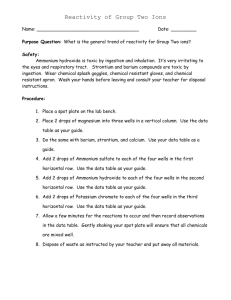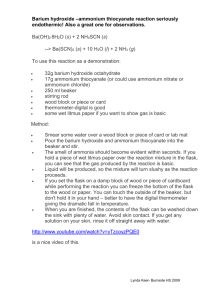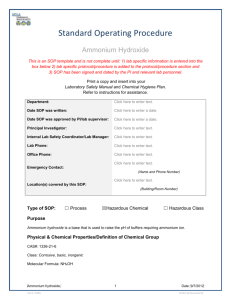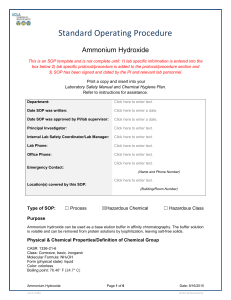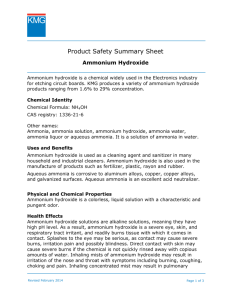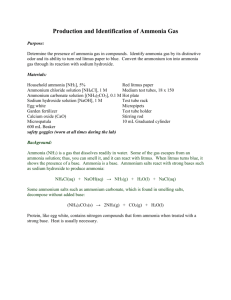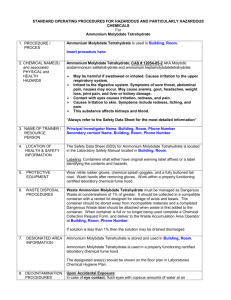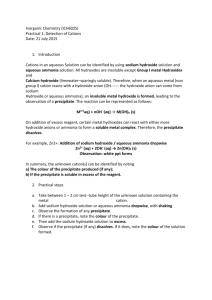Ammonium Hydroxide - WSU Environmental Health & Safety
advertisement
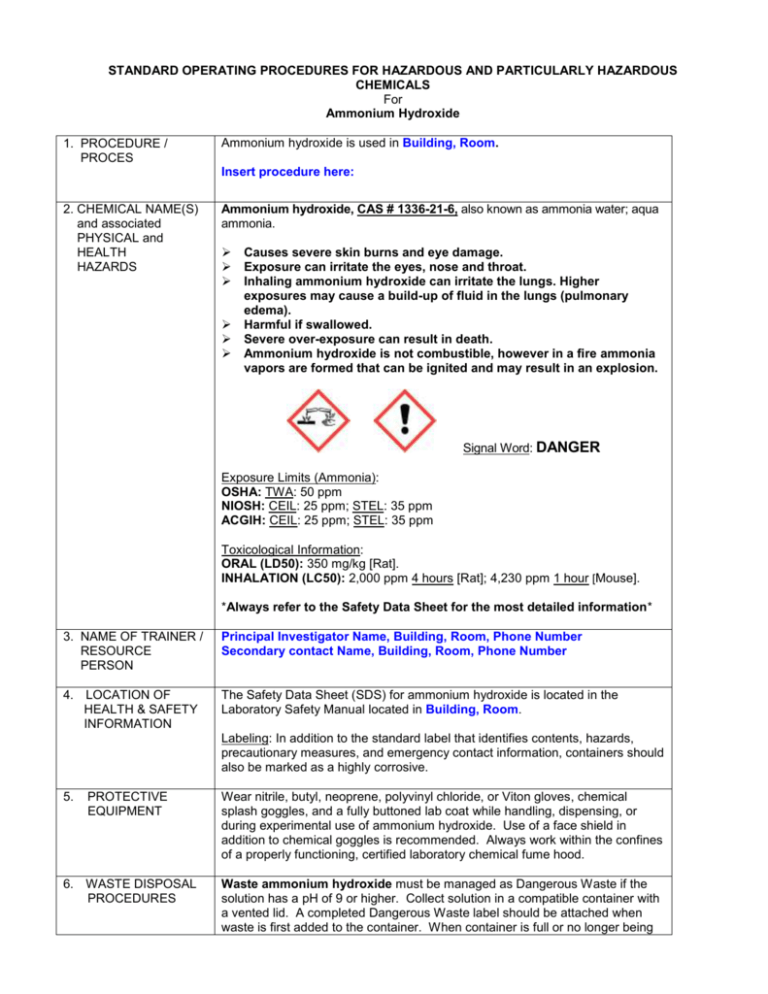
STANDARD OPERATING PROCEDURES FOR HAZARDOUS AND PARTICULARLY HAZARDOUS CHEMICALS For Ammonium Hydroxide 1. PROCEDURE / PROCES Ammonium hydroxide is used in Building, Room. Insert procedure here: 2. CHEMICAL NAME(S) and associated PHYSICAL and HEALTH HAZARDS Ammonium hydroxide, CAS # 1336-21-6, also known as ammonia water; aqua ammonia. Causes severe skin burns and eye damage. Exposure can irritate the eyes, nose and throat. Inhaling ammonium hydroxide can irritate the lungs. Higher exposures may cause a build-up of fluid in the lungs (pulmonary edema). Harmful if swallowed. Severe over-exposure can result in death. Ammonium hydroxide is not combustible, however in a fire ammonia vapors are formed that can be ignited and may result in an explosion. Signal Word: DANGER Exposure Limits (Ammonia): OSHA: TWA: 50 ppm NIOSH: CEIL: 25 ppm; STEL: 35 ppm ACGIH: CEIL: 25 ppm; STEL: 35 ppm Toxicological Information: ORAL (LD50): 350 mg/kg [Rat]. INHALATION (LC50): 2,000 ppm 4 hours [Rat]; 4,230 ppm 1 hour [Mouse]. *Always refer to the Safety Data Sheet for the most detailed information* 3. NAME OF TRAINER / RESOURCE PERSON Principal Investigator Name, Building, Room, Phone Number Secondary contact Name, Building, Room, Phone Number 4. LOCATION OF HEALTH & SAFETY INFORMATION The Safety Data Sheet (SDS) for ammonium hydroxide is located in the Laboratory Safety Manual located in Building, Room. Labeling: In addition to the standard label that identifies contents, hazards, precautionary measures, and emergency contact information, containers should also be marked as a highly corrosive. 5. PROTECTIVE EQUIPMENT Wear nitrile, butyl, neoprene, polyvinyl chloride, or Viton gloves, chemical splash goggles, and a fully buttoned lab coat while handling, dispensing, or during experimental use of ammonium hydroxide. Use of a face shield in addition to chemical goggles is recommended. Always work within the confines of a properly functioning, certified laboratory chemical fume hood. 6. WASTE DISPOSAL PROCEDURES Waste ammonium hydroxide must be managed as Dangerous Waste if the solution has a pH of 9 or higher. Collect solution in a compatible container with a vented lid. A completed Dangerous Waste label should be attached when waste is first added to the container. When container is full or no longer being used complete a Chemical Collection Request Form, and deliver to the Waste Accumulation Area Operator at Building, Room, Phone Number. If the solution has a pH between 5 and 9 it may be drained discharge. 7. DESIGNATED AREA INFORMATION Ammonium hydroxide is stored and used in Building, Room. Ammonium hydroxide is used within a properly functioning, certified laboratory chemical fume hood. The designated area(s) should be shown on the floor plan in Laboratories Chemical Hygiene Plan. 8. DECONTAMINATION PROCEDURES Upon Accidental Exposure: In case of eye contact, flush eyes with copious amounts of water at an emergency eyewash station for at least 15 minutes and immediately seek medical attention. In case of skin contact, flush skin with copious amounts of water for 15 minutes and seek medical attention. For exposure over a large portion of the body, remove clothing and shoes and rinse thoroughly in an emergency shower for at least 15 minutes. Seek medical attention immediately. In case of inhalation, move person to fresh air and immediately seek medical attention. WARNING: It may be hazardous to the person providing aid to give mouth-tomouth resuscitation when the inhaled material is toxic, infectious or corrosive. In case of ingestion, immediately seek medical attention and follow instructions on SDS. Upon Accidental Release: Large Spill: If a large amount of ammonium hydroxide is released outside the fume hood, immediately evacuate, secure the area and call 911 Small Spill: If a small amount is released (it can be cleaned up in 10 minutes) and you are appropriately trained to clean up the spill, you may do so. Use appropriate PPE including nitrile, butyl, neoprene, polyvinyl chloride, or Viton gloves, chemical splash goggles, fully buttoned lab coat and a half mask or powered air purifying respirator equipped with organic vapor cartridges and a high efficiency dust/mist filter. (NOTE: You must medically cleared, fit tested and enrolled in WSU’s respiratory protection program to wear a respirator). If it is necessary to use a respirator and personnel are not cleared to wear a respirator and not trained to appropriately clean up the spill, the employee should immediately evacuate, secure area, and call 911 to contact EH&S. Absorb the spilled material, clean the area and place cleanup materials in appropriate containers, and dispose of as dangerous waste (see above WASTE DISPOSAL PROCEDURES). Prevent entry into sewers, basements or confined areas; dike if needed. Please do not use a neutralizer to clean up spill. As with all accidents, report any exposure as soon as possible to your Principal Investigator or Supervisor. Additional health and safety information on ammonium hydroxide can be obtained by referring to the SDS or by calling the EH&S Office (335-3041). 9. SPECIAL STORAGE AND HANDLING Keep secured and store in a tightly closed dry container in a cool, dry, ventilated area away from sources of heat or ignition. Keep container tightly PROCEDURES closed until ready for use. Always add the caustic to water while stirring, never the reverse. Keep away from incompatibles such as acids, acrolein dimethyl sulfate, halogens, silver nitrate, propylene oxide, nitromethane, silver oxide, silver permanganate, oleum, beta-propiolactone and most common metals. Forms explosive compounds with many heavy metals such as silver, lead, zinc and their halide salts. It can form shock sensitive compounds with halogens, mercury oxide, and siliver oxide. POISONOUS GASES are produced in fire, including ammonia and nitrogen oxides. Certification of Hazard Assessment Is this document a certification of Hazard Assessment for the processes identified within? Yes No If yes, provide the name of the person certifying the Hazard Assessment and the date it was performed: ____________________________________________________________________________________ Name Date The location of the Hazard Assessment is indicated in the document preceding this form. Certificate of Employee Training Name of person providing training for employees working with this process: ___________________________________________________________________________________ The following employees have been trained in when, where and how to use selected PPE, the maintenance, limitations and disposal of the PPE selected, and have demonstrated the correct use of the PPE selected on the reverse of this certification. Name Date Trained ________________________________________ _______________________________ ________________________________________ _______________________________ ________________________________________ _______________________________ ________________________________________ _______________________________ ________________________________________ _______________________________ ________________________________________ _______________________________ ________________________________________ _______________________________
